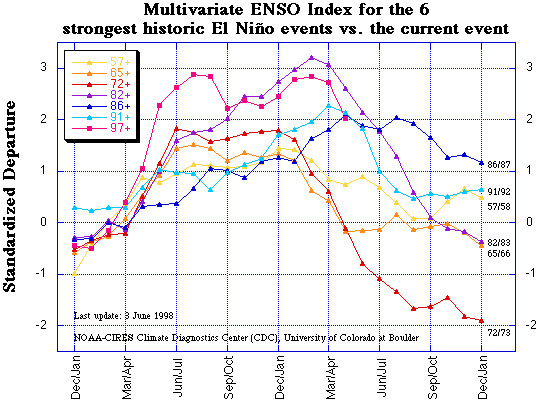Definition of El Niño
|
B. Geerts and E. Linacre |
3/’02 |
In the book we have used the term El Niño Southern Oscillation (ENSO) to refer to the interannual variation of atmospheric and oceanic conditions in the equatorial Pacific (Section 12.7). The term El Niño is defined in the book both as one phase of the ENSO (the opposite phase being La Niña), and the transient warm ocean current off Peru (i.e. the original definition). Trenberth (1) suggests that "the uninspired acronym ENSO should fall into disuse because it is tautological and an entirely unnecessary term". An El Niño event as society experiences it (with droughts in Indonesia and Australia, high SST and wet conditions near Peru, etc), he contends, is a coupled atmosphere-ocean phenomenon and should be defined as such.
Trenberth (2) proposes that the various current definitions of El Niño or warm phase (3) be replaced provisionally by a quantitative one as follows. An El Niño occurs when a positive five-month running mean SST anomaly in the Niño 3.4 Region, exceeding 0.4 K, lasts at least six months. It should be pointed out first that to analyse the evolution of SST and other parameters, the equatorial Pacific (between 5°S-5°N) has been divided in a number of regions. The Niño 3 Region is in the eastern equatorial Pacific (between 90°W-150°W, Fig 1), and the Niño 4 Region extends west of this region. The Niño 3.4 Region is in the central equatorial Pacific, bounded by 120°W-170°W.

Fig 1: Definition of the various Niño Regions in the equatorial Pacific.
Such a definition gives El Niños as occurring 31% of the time, and La Niñas (defined likewise, with a negative anomaly) 23%. The proposed definition means that the following were El Niño years (Fig 2):
1951/2, 1853, 1957/8, 1964/5, 1965/6, 1968/70, 1972/3. 1976/8, 1979/80, 1982/3, 1986/88, 1991/2, 1993, 1994/5, 1997/8.
La Niñas were these for the same period:
1950/1, 1954/6, 1964/5, 1970/2, 1973/4, 1974/6, 1984/5, 1988/9, 1995/6.
A longer time series of the ENSO cycle is shown in Fig 3. Used here is the more traditional Southern Oscillation Index (SOI), i.e. the normalised monthly-mean sea level pressure difference between Tahiti and Darwin. The SOI corresponds very well with the SST-based index.

Fig 2: Sea surface temperature anomalies in the Niño 3.4 Region from 1950 to 1998.

Fig 3. The Southern Oscillation index from 1876 to 1994. Triangles represent El Niño events and ovals La Niñas.
The ENSO cycle is loosely locked to the seasonal cycle. Most El Niño events begin between March-September, and end in February-March (Fig 4). The start and end dates of La Niñas is more variable.

Fig 4: Seasonal variation of strong El Niño events.
References
- Trenberth, K.E. 1998. Who is El Niño? EOS, 79, 170.
- Trenberth, K.E. 1997. The definition of El Niño. Bull. Amer. Meteor. Soc. 78, 2771-7.
- Aceituno, P. 1992. El Niño, the Southern Oscillation and ENSO; confusing names for a complex ocean-atmosphere interaction. Bull. Amer. Metor. Soc. 73, 483-5.